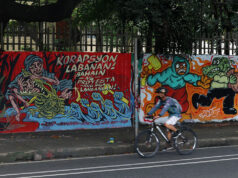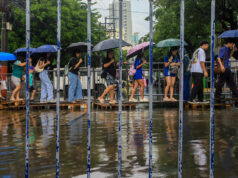Louvre Abu Dhabi draws cosmopolitan crowd on opening day
ABU DHABI, UNITED ARAB EMIRATES — The Louvre Abu Dhabi opened its doors to the public on Saturday, drawing thousands of visitors as cosmopolitan as the United Arab Emirates itself, a symbol of the Gulf nation’s ambitions on the global stage.
Light streamed down from the vast domed ceiling, the open-air museum reminiscent of a traditional Arabic marketplace.
Surrounded by water from three sides, the museum houses 600 artworks it has acquired, alongside 300 works on loan from 13 leading French institutions, in its 23 permanent galleries. The artists range from Paul Gauguin and Vincent Van Gogh to Pablo Picasso and Cy Twombly.
Inside, Emirati teenagers in flowing black robes snapped selfies next to a towering oil painting of Napoleon Bonaparte.
Hundreds of Asian, European, and Arab expatriates dressed in stylish attire roamed through the vast museum alongside Emirati couples in traditional Arabic dress.
“I’m so excited to see what’s in the Louvre. I don’t know how to pronounce it,” giggled Rachel Aquino, a Filipina nurse living in Abu Dhabi.
“LOOV,” her friend Ruby Fullon, a fellow nurse from the Philippines, pronounced.
Down the palatial rear steps of the open-air structure, Alex Viera and Marcelo de Paula from Brazil snapped photos on a platform jutting out over the sea, with traditional dhow wooden ships moored in the background.
“I’ve been to the Louvre in Paris three times… I think it’s very nice to see it here in a modern context,” said Viera.
EMIRATI, ARABIC, ISLAMIC
The Louvre Abu Dhabi, the first museum to bear the Louvre name outside France, presents around 600 pieces and has been billed as “the first universal museum in the Arab world.”
“It is a lot more than just a museum. It is a center of peace, acceptance, tolerance and education,” Mohamed al-Mubarak, chairman of the department of culture and tourism in Abu Dhabi, told Reuters.
Under the 30-year agreement, France provides expertise, loans works of art and organizes temporary exhibitions — in return for €1 billion ($1.16 billion).
The Louvre in France takes a €400-million share of that sum for the use of its name up to 2037.
For the next 10 years, the mother ship in Paris will lend works to its Abu Dhabi partner on a voluntary basis, for a maximum of two years.
For its permanent collection, the museum has acquired hundreds of pieces, dating from the earliest Mesopotamian civilizations to the present day.
Permanent installations include a sculpture by Auguste Rodin, an enormous bronze tree with mirrored branches called Leaves of Light by Italian artist Giuseppe Penone, and three engravings on stone walls bearing historic texts from the region by Jenny Holzer, an American neo-conceptual artist.
And there are priceless pieces. They include a statue of the Sphinx dating back to the 6th century B.C., 13 fragments of a frieze that reveals Surah al Hashr from the Holy Quran, and a marble bust of Alexander the Great.
Among the paintings is one by Leonardo DaVinci, done between 1495 and 1499 and called La Belle Ferronniere, or Portrait of an Unknown Woman, which was recently restored and is on loan from the original Musee du Louvre in Paris.
Louvre Abu Dhabi has partnered with museums and cultural institutions in the Arab world, who will lend 28 significant works. Among them are an 8,000-year-old, two-headed figure called the Ain Ghazal statue from Jordan, some 400 silver dirham coins from Oman and a pre-historic stone tool from Saudi Arabia.
On opening day, guided tours wound through the spacious galleries as Asian and African dance troupes performed in the open-air sections overlooking the sea.
“It is not a copy of the Louvre,” said Badria al-Mazimi, an architectural engineer.
The 26-year-old Emirati said she had visited the site when the museum was still under construction and had eagerly anticipated the public opening.
“The beautiful thing is they made it not just one building, but like a little neighborhood. When you walk around, you feel like you’re walking in an old Emirati quarter,” she said, beaming as her husband studied a Central Asian statuette dating from 1700 B.C.
“To see all these people from different nationalities waiting in this long line to visit the Louvre — it’s something really special,” she said.
“This is what you see when you travel abroad, and now it’s here, in the Emirates.”
ARABESQUE PATTERNS
More than a decade in the making, a VIP inauguration was held on Wednesday last week, with French President Emmanuel Macron among the first visitors.
The museum design, by France’s Pritzker prize-winning architect Jean Nouvel, conjures up the image of an Arab medina as seen through the eyes of a contemporary cinematographer.
A silver-toned dome with perforated arabesque patterns appears to float over the white galleries, creating what Nouvel describes as a “rain of light.”
To reach the ground, each ray of light must cross eight layers of perforations, creating a constantly shifting pattern that mimics the shadows cast by palm trees or the roof of a traditional Arab market.
Having invested over $1 billion in the museum, Abu Dhabi is hoping culture will attract tourists. Two more museums, Guggenheim Abu Dhabi, designed by Frank Gehry, and Norman Foster’s Zayed National Museum, are planned around the Louvre Abu Dhabi in the Saadiyat Cultural District that already hosts art fairs, exhibitions and performances.
“Culture is the element that will distinguish us from others,” said Saif Saeed Ghobash, director-general of the emirate’s Department of Culture & Tourism. “We will attract a different kind of traveler.”
The entrance ticket to the museum is 60 dirhams ($16.30) with all 5,000 tickets sold out for the opening day. — AFP/Reuters



